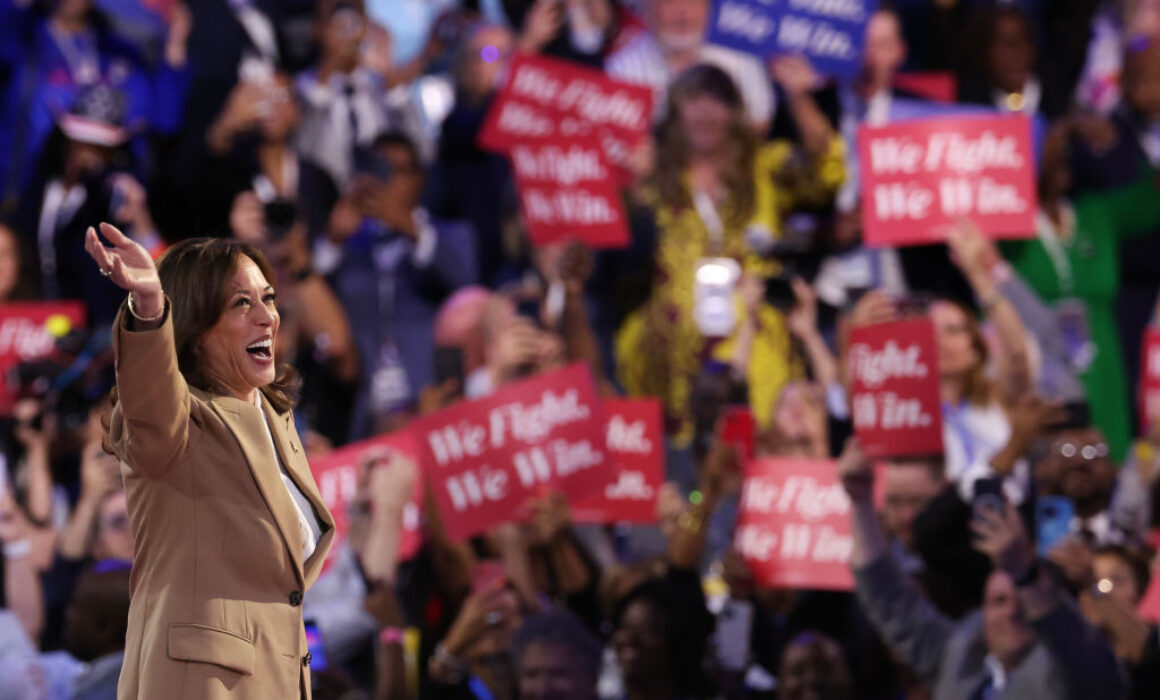Economic Ideas: The Key to Long-Term Democratic Unity
August 26, 2024
By Felicia Wong
Fireside Stacks is a weekly newsletter from Roosevelt Forward about progressive politics, policy, and economics. We write on the latest with an eye toward the long game. We’re focused on building a new economy that centers economic security, shared prosperity, and rebalanced power.
(Photo by Getty Images)
Democratic joy is the biggest headline as the 2024 Democratic National Convention in Chicago comes to a close. And it’s not just vibes. Democrats are winning the war of ideas. The electoral race and the policy race are both still hotly contested, but recent polling shows Kamala Harris edging out Donald Trump as the presidential candidate Americans trust more on the economy. One reason Harris might have momentum in policy surveys is that Democrats are increasingly unified, with each other and with the American public, about how our economy can work better—and why government needs to help make that happen.
As Anand Giridharadas and Ezra Klein have both noted, Democrats now seem to agree on some fundamental economic principles. This is a coherence we saw emerge in the years after the Great Recession, accelerate during the Biden-Harris administration, and stand out during this week’s DNC. And while the threat of a second Donald Trump presidency has of course been central to fostering Democratic unity in this election season, the just-concluded convention offered hope that party unity can outlast that threat—because it has an ideological foundation as well.
Alexandria Ocasio-Cortez’s Monday night speech captured it well: “In Kamala Harris, we have a chance to elect a president who is for the middle class because she is from the middle class. She understands the urgency of rent checks and groceries and prescriptions. She is as committed to our reproductive and civil rights as she is to taking on corporate greed.” And Harris affirmed that commitment in her acceptance speech last night: “Building that middle class will be a defining goal of my presidency.”
The power of any truly successful economic worldview goes beyond the technical analyses of taxing, spending, and regulating; it’s political, built on ideas that resonate and speak to people’s lives. (There’s a reason that people across the country can still tell stories about how New Deal programs benefited their families.)
The economic vision Democrats are increasingly united around—building the middle class—rests on two big principles.
First, a full-employment economy for workers. This means an economy in which jobs are plentiful, and where employers have real-world incentives to make those jobs better, so they are actually middle-class. It means an economy where workers can join a union, bargain for higher wages, and walk away from a bad deal.
And second, healthy, competitive markets that foster innovation rather than exploitation. In such markets, corporations cannot hold and wield excessive power to suppress competition and set unfair prices and wages. Instead, government makes and enforces guardrails against companies that exploit, deceive, or otherwise take advantage of people.
Taken together, these principles offer a one-two punch strategy of economic governance, holding together a liberal-progressive political coalition that may differ on some of the policy specifics, but is traveling in the same direction. These principles yield good policies. Government action in recent years has delivered record employment numbers and effectively pushed back against all kinds of abuses of corporate power, from worker noncompetes to excessive junk fees.
In the United States, with our fractious and sometimes frustrating two-party system, a shared ideas foundation—about how to govern, for whom, and to what ends—is especially important for party functioning.
And we have seen, in the last three-plus years and in the last few weeks, that the backbone of the Democratic Party’s ideas is becoming a steel spine.
Economic Ideas Are Holding the Party Together
The Democrats are in the midst of one of the highest-stakes political leadership changes in modern history. Joe Biden and his team stepped aside. Kamala Harris and her team stepped forward. This is still a political party that spans the ideological and geographic gamut, from Alexandria Ocasio-Cortez and Bernie Sanders to Gary Peters, Jon Tester, and Marie Gluesenkamp Perez.
But a shared economic philosophy is holding these Democrats together. They agree on who they are fighting for: Ocasio-Cortez invokes the bartender; Sanders the teacher; Peters the union pensioner; Tester the family farmer; Gluesenkamp Perez the auto mechanic. These are very different politicians. They are certainly not all progressives. But they agree that corporations—from Big Ag and Big Tech to Big Pharma and Big Oil—have too much power over workers’ livelihoods; that this power allows a few executives to take home profits at everyone else’s expense; and that a financialized system where shareholder value is king makes this all far worse. They agree that government should ensure that companies play by the rules and that workers can bargain for better wages, better working conditions, and a say on the job.
Beginning in 2020, before he was even elected president, Joe Biden helped architect this agreement. His transition team prioritized hiring a diverse and wide range of policy staff, and was intentional in bringing the Sanders and the Warren wings into the coalition (you can see the handprints of the Biden-Sanders Unity Task Force in today’s platform).
In 2021, the Biden team surprised many who worried about a too-meager approach to the pandemic and economic recovery with a robust all-of-government set of investments in the American people, from the expanded Child Tax Credit to rental assistance. And he didn’t stop at just addressing urgent recovery needs. The American Family and Jobs Plans proposed investments to address decades-long efforts to hollow out government capacity, economic resiliency, and supports for working families. Many of these proposals became real with the passage of the Inflation Reduction Act in 2022, even though key pillars failed to make it through the filibuster-prone negotiation process.
Now Kamala Harris is inheriting and extending that basic architecture. She has made it her own, and updated it for the economy of 2024. Harris is putting more emphasis on medical debt in addition to student debt, on the cost of housing and the cost of childcare, on teachers and home care attendants in addition to construction workers. It is clear that Kamala Harris and Joe Biden inhabit the same philosophical home.
As Frank Foer wrote this week, “[Harris] surrogates have portrayed her as the implacable enemy of corporate greed . . . [Her] convention felt like a union hall.” This is not, he says, “just a matter of disciplined messaging on national television. Economic consensus has shifted in the direction of populism, in response to rising inequality, China’s abusive trade practices, and the lessons of the pandemic.”
This foundational level of agreement was not—is still not—a foregone conclusion. Nor does it extend across the full range of policy issues, as has also been on display this week. We will see intraparty fights over economics. Neoliberalism, even in zombie form, remains a powerful force for both Republicans and Democrats. An argument about whether the FTC is, in fact, right to go after Big Tech is underway. We will see plenty of battles about how much to use tax revenues to pay down the deficit—if we can even raise meaningful levels of tax revenues. But step back from the day-to-day. Democrats are coming to a shared economic understanding.
And as neoliberalism’s endurance over five decades has shown us, that kind of agreement can win far more than a single election.
The True Power of Neoliberalism: Fusion
Neoliberalism’s deepest power was not its economic prowess. Neoliberalism endured, and still haunts us, because it provided a frame on which very different conservative—and even, by the 1990s, triangulating Democratic liberal—factions could agree, making “free” markets society’s most important organizing principle.
This was a political triumph, bringing together disparate blocs—Mt. Pelerin Society economists; conservative legal scholars; corporate CEOs and other titans of industry; evangelical Christians; and opportunistic politicians, Ronald Reagan chief among them and the most successful—with promises of simplicity and clarity amid the chaos after Watergate, Vietnam, and the sexual revolution.
An economics that promised stability emerged and prevailed. Milton Friedman wrote a bestseller about capitalism and freedom. Economic growth would be fueled by well-managed corporations providing good jobs for Americans and the freedom of choice in a marketplace of abundance, mothers and fathers sending their children to school for the promise of a stable income on the other side. Never mind that the factions were still factional, that the preachers and the libertarians didn’t always agree on abortion rights or civil rights. Neoliberal ideas had something for everyone: tradition, calm, order. People could take what they wanted, and leave the rest.
That adaptability helped market supremacy transcend party. As the historian Gary Gerstle posits, a political order has taken hold when both sides of the aisle and both political parties essentially agree on things so fundamentally that they refuse to challenge some basic ideas. True, Democrats and Republicans found plenty to fight over—how much or little to tax, where and how to regulate energy or media. But by the 1990s, American neoliberalism had become a shared framework for both Democrat and Republican policymakers. Without government supporting the right to unionize and curbing the international power of capital, workers were forced to settle for what they could get.
Today, the age of neoliberal hegemony is over. The ideas failed on their own substantive terms, and the litany of ills is familiar. Tax cuts delivered deficits and rampant inequality, not endless growth and shared prosperity. Deregulation brought financial crises and ballooned corporate consolidation. Union-bashing yielded bad jobs—and radically destabilizing inequality that continues to haunt American society.
Now, the question is what Democrats and Republicans will do to rebuild a shared framework in the post-neoliberal age.
Whither the Parties?
Without the neoliberal backbone, the Republican Party is, to put it charitably, unfocused. They are lurching aimlessly and confusingly through a swamp of different, conflicting notions of how our economy should work. Many big-company CEOs still want a 1980s-style pro-Wall Street, low-taxes, low-regulation agenda—zombie neoliberalism in its purest form. Donald Trump loudly argues for a new economic nationalism focused on across-the-board tariffs and deporting millions of immigrants, while his vice presidential pick struggles to decide if he supports antitrust enforcement and expanded child tax credits. And some propose a patriarchal, throwback conservative post-neoliberalism—a “worker”-focused economics rooted in male workers leading heteronormative families.
The Democrats, by contrast, have a set of ideas that might just actually hold its factions together. The transition to Kamala Harris as the de facto head of the Democratic Party is beginning to make this clear. Government must ensure that corporations and workers share in the balance of power, and share in the rewards of our economy. Harris has embraced this message during her narrow campaign trail window because it works with the American public, and because it has already proven to drive economic growth that shifts the power in our economy from corporations and shareholders to workers and families.
And now? The work begins.
I said this five years ago, and it might be even more true today: Now is the time to focus not only on ideas, but also on strategy—organizing and building the kinds of alliances that can develop into robust networks, institutions, and political power. The road ahead is steep, but on the economics, we are beginning to see the kind of political agreement—both difficult and foundational—that makes building lasting power possible.
If You Ask Eleanor
“It happens that on nearly all big issues we agree, but any two people are bound to differ now and then, on method if not principle.”
– Eleanor Roosevelt, If you ask me (September, 1941)



